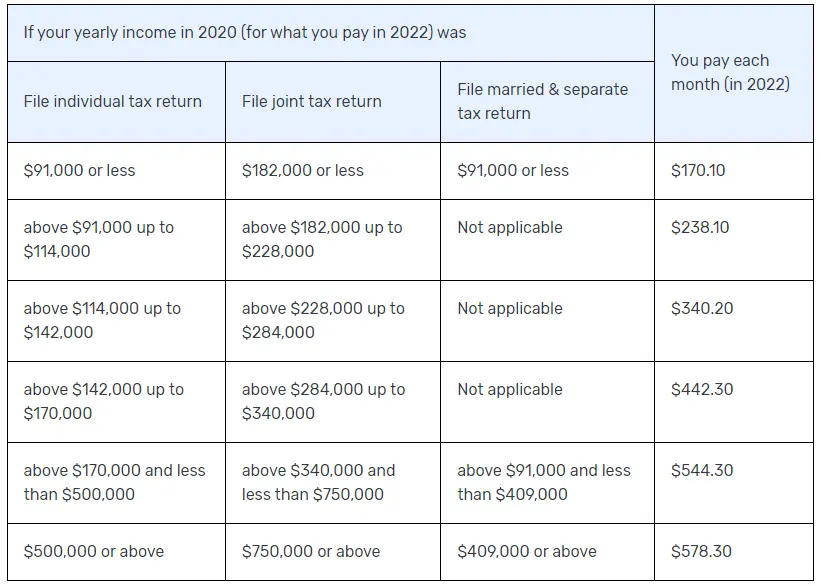What Is Medicare Part B?
Learn More about Your Health Care Options with PolicyScout’s Guide to Medicare Part B.
Our content follows strict guidelines for editorial accuracy and integrity. Learn about our and how we make money.
It’s estimated that over 2 million people signed up for medical insurance through Medicare in 2021. In California alone, there are over 6 million people who use Medicare as part of their health coverage.
If you haven’t read our guide to Medicare, be sure to take a look. In it, we discuss the different types of Medicare options available and how you can get complete coverage for your medical expenses during your retirement.
Read through our guide if you want to learn more about Medicare, medical insurance, outpatient services, costs, and how to sign up for Part B cover.
Medicare and Health Insurance in the U.S.
Medicare is a government-sponsored health care plan composed of Part A and Part B, as well as Part C (now known as Medicare Advantage), and Part D. There are also various Medicare Supplements Plans that range from A - N.
The Different Parts of Medicare:
Medicare Part A relates to inpatient or hospital-related medical costs.
Medicare Part B refers to outpatient or non-hospital medical costs.
Medicare Part C (Medicare Advantage) consists of private plans that cover Part A, B, and D medical costs.
Medicare Part D has to do with self-administered prescription drug coverage.
Original Medicare, Medicare Advantage, and Part B
Original Medicare is government-administered medical insurance, while Medicare Advantage (Part C) plans are run by private companies that have been contracted into the Medicare program.
Both Medicare Advantage and Original Medicare plans cover Part B medical costs.
However, if you’re planning on enrolling in Original Medicare you will have to register for Part B separately.
With Medicare Advantage, you’ll receive coverage for Part A, Part B, and Part D expenses in a consolidated plan.
Medicare Advantage providers also offer different types of coverage. If you’d like to learn more about these types of coverage, see our guide to Medicare Advantage (Part C).
Coverage for Part B expenses will be different in each state and for each Medicare insurance company.
This is because many Medicare Advantage insurance companies use in-network providers for their members, which allows them to charge different rates.
Be sure to check with your insurance company or the Social Security Agency (SSA) to determine how extensive your coverage is.
You can also reach out to PolicyScout with your Medicare-related questions and we’ll gladly help you learn more about your coverage options.

(Source: Pexels)
Where Does Medicare Part B Fit In?
Medicare Part B deals with medical expenses that are considered to be outpatient or out-of-hospital costs. These can include checkups, blood tests, scans, or a consultation with a specialist.
If the treatment or service is short term or immediate and doesn’t require you to be admitted to the hospital, the expense would fall under Part B.
Part B Coverage Examples
| Covered by Part B | Not Covered by Part B |
|---|---|
| Doctor Consultations. | Prescription Medicine Costs. |
| Annual Physical Exams. | Surgery. |
| Laboratory Tests Such as Bloodwork. | Hospital Stays. |
| Mental Healthcare. | Professionally Administered Care in a Hospital Setting. |
| Ambulance Services. | Inpatient Rehabilitation. |
| Outpatient Treatment at a Hospital. | Skilled Nursing Care. |
| Medical Equipment. |

(Source: Pexels)
What Does Medicare Part B Cover?
Part B covers two kinds of out-of-hospital or outpatient medical expenses—medically necessary services and preventive services.
Medically necessary services are treatments and supplies needed to diagnose or treat a medical condition. Preventive services are healthcare procedures, such as tests and consultations, that detect or prevent illness and disease. It’s important to remember that Part B doesn’t cover the entire cost of your treatment. You also won’t be able to use your Part B coverage if you travel overseas.
Your Part B insurance will usually pay 80% of the cost for your treatment, and you’ll have to cover the remaining 20% along with an annual deductible cost.
If you visit your health care provider for an annual checkup or go to your local clinic for treatment, these expenses will fall under your Part B coverage.
Medicare Part B will pay in part for medical expenses such as durable medical equipment (crutches, wheelchairs, etc.) and preventative care (blood pressure tests, cancer screenings, etc.).
If medication is administered at a clinic or a doctor’s office, it will be covered by Part B. However, Part B won't cover self-administered prescription medications (Part D), or services like dental procedures, eye tests, or hearing exams.
People who use Original Medicare will take out additional cover, like Medicare Part B supplemental insurance plans (Medigap) or medical savings plans (MSPs) to cover the additional costs like copayments, deductibles, and out-of-pocket expenses.
These plans offer an added level of protection against medical costs and work as insurance plans for gaps or shortfalls in your Medicare cover.

(Source: Pexels)
What Does It Cost to Enroll in Part B?
In 2022, you can expect to pay between $170.10 and $578.30 per month to get Part B cover through Original Medicare.
Because Part B coverage is optional and based on your income, the month-to-month cost of enrolling is different for each person.
If you are part of a Medicare Advantage scheme, the type of plan you use will also affect your monthly premium. For example, if you sign up for HMO (Healthcare Maintenance Organization), your monthly premium might be $160.00. But, if you sign up for a PPO (Preferred Provider Organization) plan, you could pay $250.00 per month.
You can learn more about the different types of Medicare Advantage plans in our Medicare Part C guide.
Enrollment Costs for Part B
This table is sourced from the official Medicare website and gives an indication of what you would pay each month to get standalone Part B cover. Your premiums are based on your tax returns for the previous year.

As seen in this table provided by Medicare, monthly pricing for premiums is dependent on your income and sometimes even your marital status. (Source: Medicare)
Medicare Part B: Out-of-Pocket Expenses, Deductibles, Excesses, and Coinsurance
As with all Medicare expenses, your plan won’t cover 100% of your bills. There are other charges that need to be paid by you before and after receiving Medicare benefits. These expenses are called deductibles, coinsurance, and out-of-pocket expenses.
Deductibles are costs you have to pay for treatment before you can get Medicare coverage for each period.
Your deductible is usually a fixed amount per year. For 2022, the Part B deductible is $233.00.
There are also limits to the coverage you can get for Part B expenses, and anything above your cover limit will have to be paid out of your pocket.
When people talk about out-of-pocket expenses and Medicare, these terms are what they are referring to. Deductibles, coinsurance, and excess amounts are what you need to pay for personally.
For example, let’s say you sprain your ankle while walking. You go to your doctor, who performs an X-ray, bandages up your foot, and prescribes some pain medication. In total, the bill for your treatment amounts to $2,500.00.
You’ll first have to make sure that your deductible is paid for the current period of coverage. Then Medicare will cover 80% of the billed expenses and you will have to pay the remaining 20%. In this case, you’d pay $500.00 and Medicare would cover $2,000.00 for your treatment. Your prescription pain medication wouldn’t be covered by your Part B insurance, but rather by your Part D prescription drug coverage.
If you’re worried about high medical expenses, a good option for many Original Medicare members is to take out a Medicare Supplement Insurance Plan that will take care of unforeseen costs if they occur.
PolicyScout can offer you some great options for comprehensive Medicare Supplement Plans, give us a call if you’d like to learn more.

(Source: Pexels)
What Are Part B Excess Charges?
Doctors are allowed to charge their own rates for services and Medicare will only cover approved amounts. If services cost more than the prescribed limits, you might have to pay more or even the full amount of these excess charges.
Always check with your health care professional, caregiver, or facility whether they participate in Medicare. If you’re on a Medicare Advantage plan, check to see if your doctor or medical specialist is on their network.
Claiming Back Expenses from Medicare Part B
Sometimes you may have to pay the entire medical cost upfront and claim back from your health care provider. If you want to claim an expense back through Medicare, you’ll need to submit a Medicare Part B reimbursement form to the Center for Medicare and Medicaid Services (CMS) or your Medicare Advantage provider.
This form is available in English and Spanish through the CMS website. Download it, fill it in, and send it to your Medicare Part B provider to claim a refund.
Dates for Medicare Part B Enrollment
Keep these important dates in mind when applying for Medicare Part B cover. You can find out how to do this below.
The general enrollment period for Medicare is January 1st to March 31st each year.
Your initial enrollment period (i.e. your first time enrolling in Medicare) starts three months before the month of your birthday and ends three months after the month of your birthday.
Your special enrollment period is 8 months from when your employment ends.
How Do I Apply for Medicare Part B?
There are two ways you can go about enrolling for Medicare Part B: through Original Medicare or through a Medicare Advantage plan.
Before you get started, remember that you can sign up between January 1st and March 31st every year during the general enrollment period.
If you have never enrolled in Medicare before and are turning 65, you have seven months (three months before, and three months after your birthday month) to enroll.
There are also special enrollment periods outside of the general enrollment period. If you qualify, you can apply for Part B cover up to eight months after your job-based insurance or employment ends without having to pay a penalty.
Medicare Part B Penalties
Penalties for not enrolling in Part B can be expensive and are permanent. You will be charged 10% of your current premium for each twelve-month period you were not signed up while eligible.
For example, if you decide not to join a Medicare Part B plan for five years, you will have to pay your monthly premium, plus a 50% (5 x 10%) penalty fee for the rest of your life. This would turn a $207.90 Part B monthly premium into $311.85.
If you’re interested in signing up for Medicare Part B, the easiest way is to use the Social Security website’s online portal or to get in touch with a trusted Medicare advisor in your area.
It’s important to remember that you must sign up for Medicare Part B separately from Medicare Part A. If you need more assistance with this, contact PolicyScout for more information on how you can determine and pay your Part B penalties.
Some tips for enrolling in Medicare Part B
Check whether or not you might be automatically enrolled for Medicare Part B when you signed up for Medicare Part A.
Check with the SSA or your Medicare Advantage provider to see when the enrollment period is and whether you can enroll.
Shop around for a Medicare Advantage plan in your state if you 'd like a wider range of health care options.
See if you’re up to date with your Medicare contributions (at least ten years), before applying—that way you’ll know if you have to pay more to enroll.
Speak with a Medicare expert like PolicyScout to find out what coverage plans are available in your area.
How Do I Cancel My Medicare Part B Insurance?
If you’re wondering, “can I opt-out of Medicare Part B?” the answer is yes, but we highly recommend that you consider the consequences before doing so.
There are a lot of reasons why someone might not want to have Medicare Part B. For example, if you’re over the age of 65, still working, and receive medical coverage through your employer, having the extra cost of monthly Part B premiums might not be ideal.
If you decide to opt-out of Medicare Part B, remember that if you ever want to reinstate your Part B insurance you will be liable for a permanently higher monthly premium of up to 10% for each year that you weren’t enrolled.
Before you consider ending your Part B coverage, speak to your Medicare provider or do some research into the different Medicare Advantage plans available to you. You might be able to find something that is more affordable or in line with your current circumstances.
Contact a consultant from PolicyScout to learn more about your different options. Because we’ve done our research on Medicare Advantage plans, Medigap Supplement Plans, and Medicare, we’re able to give you insights into which providers offer great plans.
How Do I Find Out More about My Outpatient Health Care Coverage?
PolicyScout has guides and helpful articles on everything to do with Medicare, so be sure to check out our Medicare Hub to find out more about the options in your area.
We’ve got tons of information on the different Medicare options available and post new articles every month.
PolicyScout also offers expert consultations to seniors and other American citizens looking to enroll in Medicare or other health insurance policies.
Reach out to us via email or telephone with your questions to have a professional assist you with your Part B and Medicare-related questions.

(Source: Pexels)
FAQs about Medicare Part B
What does Medicare Part B cover?
Medicare Part B expenses include any medical cost that isn’t related to prescription medication (Part D) or doesn’t require hospitalization (Part A). These can include things like doctor’s visits, blood tests, X-rays, ambulance services, and home health care.
What does Medicare Part B cost per month?
Premiums for Medicare can range depending on your taxable income. According to the Medicare government website, you can expect to pay anywhere from $170.10 to $578.30 per month.
How do I sign up for Medicare Part B?
You can sign up for Medicare Part B through the SSA website or by purchasing a Medicare Advantage plan. Both options are easy to do; however, be aware of your coverage options before you commit to either Original Medicare or one Medicare Advantage provider.
Can I opt out of Medicare Part B?
Yes, signing up to Medicare Part B is optional and you can unenroll from the plan if you want to. Though it is inadvisable, you can do so by contacting your Medicare Advantage provider or by calling the SSA.
Is it mandatory to have Medicare Part B?
No, you don’t have to sign up for Part B coverage if you are eligible. However, if you decide you want to join a Part B plan at a later stage you will have to pay a penalty fee on top of your monthly premiums.